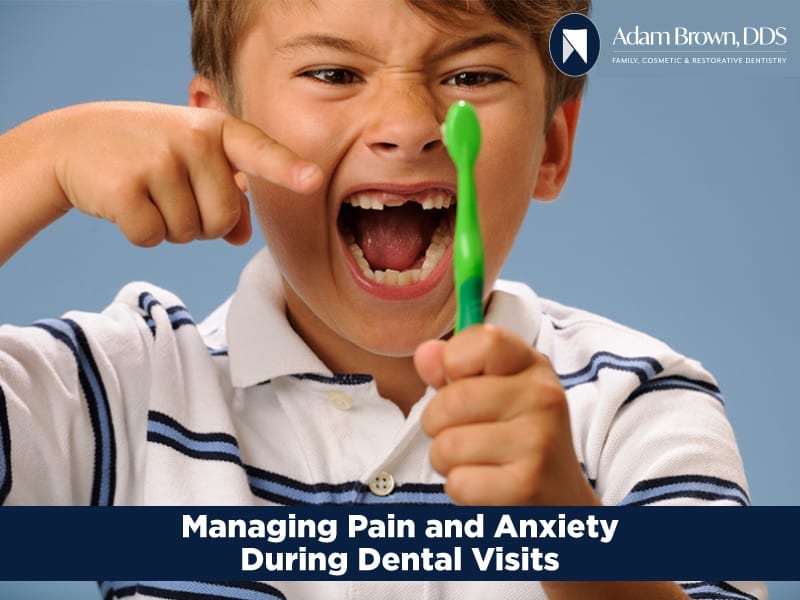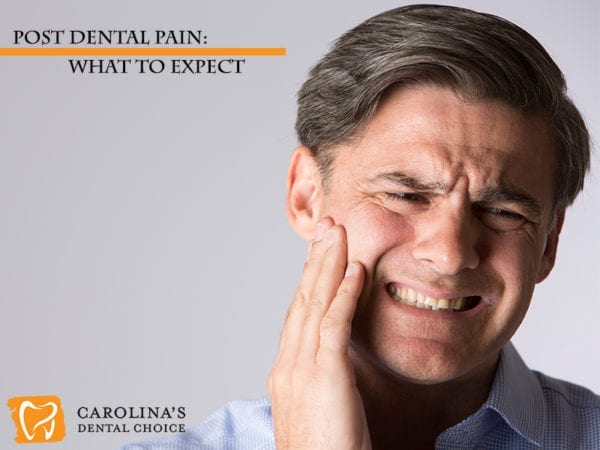Managing Pain and Anxiety During Dental Visits

It’s no secret that regular dental visits are an important tool for maintaining good oral health. Despite this, as much as 36% of the population fears a visit to the dentist and 1 in 25 suffers from dentophobia (extreme fear of dental visits). While there are many reasons people might have anxiety around a trip to the dentist, there are also a number of ways that both you and your dentist can help to alleviate those fears.
Pain and Anxiety Management
Fear of pain is the number one reason people are afraid to visit the dentist. And while having your teeth worked on won’t necessarily be something you look forward to, it also doesn’t have to be something you fear. Technology has come a long way when it comes to anxiety and pain management. Here is a list of some of the tools you and your dentist have at your disposal to combat any fears that might arise.
Pain-Free Shots – Let’s just say it. Shots are scary. For all of us. No one likes to be poked with needles, especially in their mouths. However, dentists have multiple options at their disposal to help make the experience of getting a shot much easier and a whole lot less scary. If they aren’t already, ask your dentist to use an anesthetic gel or rinse to help numb your mouth before administering the shot. This will desensitize the area and lessen pain significantly.
Studies have also shown that the speed at which a shot is administered can affect the level of discomfort a person experiences. The general rule of thumb is “the slower the better” when it comes to administering numbing medication. If your doctor gives you novocaine, expect it to take approximately 60-90 minutes to wear off after the procedure depending on the amount given.
Providing distraction – Oftentimes dentists will offer various forms of distraction that can help to lessen a person’s anxiety and make it easier to get through a procedure. Some of these distractions include tv’s on the ceiling, movie headsets that immerse you in a world outside of your current situation and soothing aromatherapy scents such as orange and lavender. Some dentists even go so far as to have a spa-like atmosphere that provides perks such as a manicurist and reflexologist to be available during procedures.
Oral Pain Relief – If an alternative to a shot is needed, there are various oral solutions that can be considered. The first option is the use of nitrous oxide (N2O). We all know nitrous oxide from our childhood by its informal name of “laughing gas”. N2O works to relax you and provide you with a more pleasurable emotional feeling. Pain is intensified when we are stressed or anxious so allowing yourself to relax can be an effective method of management. In addition, N2O is considered safe and effective because it begins to work quickly and the effect is completely reversible with no long-lasting effects. When used for a dental procedure, you will recover quickly enough afterward to be able to drive yourself home.
Another oral method used to help people alleviate the fear of a trip to the dentist is a pill called Halcion. Halcion is a member of the Valium family and is usually administered an hour or two before work is done. Some dentists will also provide a pill the night before to ensure the patient has a full night’s sleep. When this pill is used, patients can feel sleepy and relaxed but are still able to communicate with the dentist.
Electronically Delivered Pain Relief – An alternative to injection, this type of pain relief is commonly known as transcutaneous electrical nerve stimulation or TENS for short. TENS uses low voltage electricity to help alleviate pain. Your dentist will place adhesive pads on your face in the area where they are working and send a low current through in order to achieve numbness. TENS can help to relax your jaw and facial muscles, a commonly tense area when people experience anxiety.
Laser Drills – While not yet formally approved by the American Dental Association, the organization says that they are cautiously optimistic about how this technology can influence the future of dentistry. Laser drills provide an alternative to traditional drills by using the energy from light to cut or vaporize infected tissues. This form of treatment is less invasive and less painful than traditional methods currently being used. A few examples of how lasers can be used in dentistry include treating tooth decay, remedying issues associated with gum disease, performing biopsies and whitening teeth.
IV Sedation – If more moderate sedation is needed, a dentist will sometimes use IV sedation. One advantage to this form of sedation is that the dentist has direct control over the levels you are given and can quickly adjust to meet your individual needs.
Additional Sedation Options – While family dentists don’t perform deep sedation or general anesthesia, sometimes when you are referred to a specialist, you may encounter these options. In order to administer deep sedation, providers need to complete a program through CODA (Commission on Dental Accreditation) focusing on deep sedation and general anesthesia. Typically this accreditation is completed by oral surgeons and dental anesthesiologists.
Post Dental Pain – What to Expect
While pain management during dental treatment is important, understanding pain post-treatment is equally as important. Having the ability to discern between what type of pain is normal versus when it is necessary to contact a professional can be a huge advantage for someone who is anxious about their recovery. Here are a few examples of different types of pain you might experience after a visit to the dentist.
when it is necessary to contact a professional can be a huge advantage for someone who is anxious about their recovery. Here are a few examples of different types of pain you might experience after a visit to the dentist.
Jaw Soreness/Tenderness – This type of pain is one of the more common types experienced after a dental procedure. It occurs because of your mouth being held open for an extended period of time. The muscles in your mouth are no different from the muscles in any other part of your body. Use them more than they’re used to being used and they’ll become sore and tired. One way to remedy the pain is to ask your dentist if he has a bite block available for you to use. A bite block will allow your jaw to rest while still allowing the dentist to perform dental work. If you do experience this type of pain, it will typically clear up after a day or two depending on the procedure. For people who grind their teeth, it may take slightly longer as grinding is also a major cause of jaw soreness.
Pulpitis – Pulpitis is caused by an inflammation of the pulp within the tooth. It can feel like the sudden onset of a toothache. Pulpitis can also cause hot and cold temperature sensitivity within a tooth. This type of pain can occur after any dental procedure where a tooth has been worked on from a filling to the repair of a cracked or chipped tooth. There is both reversible and irreversible pulpitis. With reversible pulpitis, you won’t feel pain unless something comes in contact with the tooth to affect its sensitivity. However, irreversible pulpitis is a constant pain that typically requires a root canal to remedy. Irreversible pulpitis is not a common side effect of performed dental work, rather, it is typically a sign that dental work may be necessary.
Referred Pain – Referred pain is when you feel pain in other areas of your body than where the pain originated. So, for example, while you might have had a root canal on your molar, your eye sockets or ears may experience pain as a result. Referred pain can be experienced from any traumatic event and can sometimes be a sign of something more serious. If you experience referred pain that doesn’t go away within a week of your procedure, be sure to check in with your dentist and let him know about the symptoms you are experiencing.
Methods for Addressing Post Dental Pain
While there may be no sure-fire method to completely escape the discomfort that comes after a dental procedure, there are ways to lessen the pain and make recovery a more pleasant experience. A few suggestions for improved recovery time are listed below.
- Eat an anti-inflammatory diet before you go to the dentist. Focusing on foods that help combat inflammation will improve your overall recovery time.
- For those with TMJ/TMD, focus on relaxing your jaw before your procedure. Consciously working to relax and stretch your jaw muscles will help reduce pain post-procedure.
- Check for a bite block. As stated above, asking if your dentist has a bite block available can lead to a lot less pain and discomfort after the work is over.
- Relax! While this tactic is obviously easier said than done, it’s a known fact that stress will tense your muscles and cause a longer recovery as a result. Practicing mindfulness and focusing on your breathing can go a long way towards bringing down the levels of stress associated with a dental procedure.
Of course, taking an anti-inflammatory such as ibuprofen or acetaminophen is also a perfectly acceptable way to deal with pain after a procedure. If your dentist prescribes medication, be sure to follow all the directions associated with it and never share a prescription with someone else. If for any reason, your pain doesn’t diminish or feels like it’s getting worse, call your dentist and set up an appointment to check and make sure everything is healing the way it should.
Pain isn’t fun for anyone. The good news is that there are several tools at your dentist’s disposal that they can use to help you through a procedure with a minimal level of discomfort. While the dentist’s chair can sometimes seem like a scary place, remember that first and foremost, they are there to help you maintain a strong, healthy smile. They have their teeth worked on the same as you and, like you, they also desire an outcome that doesn’t leave pain in its wake.
Our dentists are sensitive to your needs and are always happy to speak with you about the options we provide when it comes to pain control. Please feel free to call anytime during office hours and we’ll be happy to set up a consultation for you to learn more.
Works Cited
Boge, Emily. “Dental Phobia, Fear of Dentist & Anxiety: Colgate Oral Care.” Dental Phobia, Fear of Dentist & Anxiety | Colgate Oral Care, https://www.colgate.com/en-us/oral-health/basics/dental-visits/how-dental-phobia-develops-and-what-offices-do-to-help-0515.
Collins, Sonya. “Do You Dread the Dentist?” WebMD, WebMD, https://www.webmd.com/oral-health/features/dentist-anxiety#1.
“Controlling Anxiety and Pain at the Dentist’s Office.” WebMD, WebMD, https://www.webmd.com/oral-health/controlling-dental-pain#1.
DDS, Mark Burhenne. “Pain After a Dental Visit: What’s Normal, and What’s Not.” Ask the Dentist, 30 Aug. 2019, https://askthedentist.com/pain-dental-visit/.
Garret-Bernardin, Annelyse, et al. “Pain Experience and Behavior Management in Pediatric Dentistry: A Comparison between Traditional Local Anesthesia and the Wand Computerized Delivery System.” Pain Research & Management, Hindawi Publishing Corporation, 2017, https://www.ncbi.nlm.nih.gov/pubmed/28293129.
Kasat, Vikrant, et al. “Transcutaneous Electric Nerve Stimulation (TENS) in Dentistry- A Review.” Journal of Clinical and Experimental Dentistry, Medicina Oral S.L., 1 Dec. 2014, https://www.ncbi.nlm.nih.gov/pmc/articles/PMC4312687/.
“Laser Use in Dentistry.” WebMD, WebMD, https://www.webmd.com/oral-health/guide/laser-use-dentistry.
“Sedation Dentistry: Can You Really Relax in the Dentist’s Chair?” WebMD, WebMD, https://www.webmd.com/oral-health/sedation-dentistry-can-you-really-relax-in-the-dentists-chair#1.
